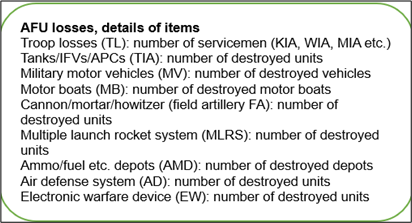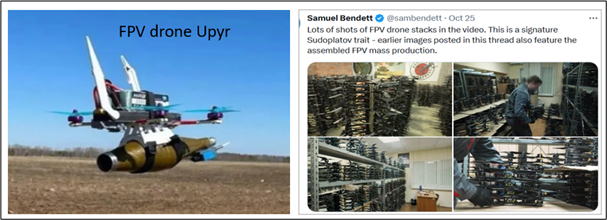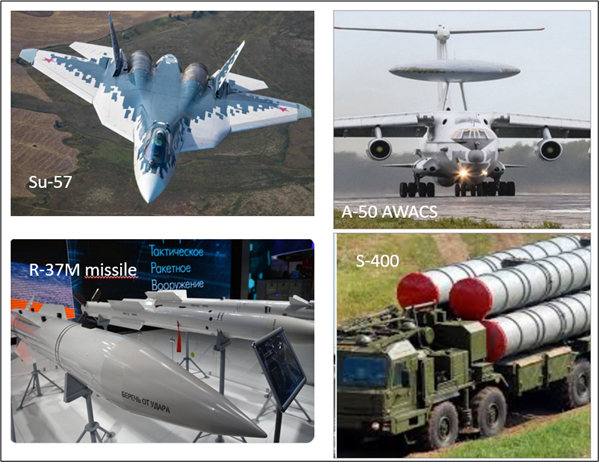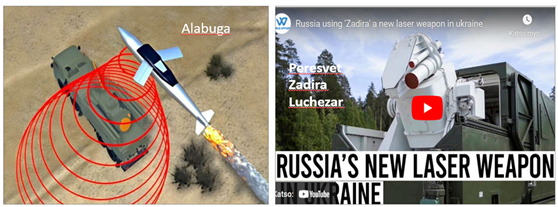Air superiority – game changer in Ukraine war
This statement “Russian air superiority is the game changer in the Ukrainian war” relies on evidence-based military performance in real time combat during the warfare in Ukraine.
First in this article, there are some general important notes, characteristics and conclusions derived from the actual warfare of the last 20 months with practical examples of performance, the latest warfare data and finally, the list-type short presentation of some new Russian devices and equipment. The wider presentation of these novelties will be provided later in the basic text of my website. I will inform readers upon this release.
I have analyzed this and related topics already before in my basic text on my website, link here below:
Revolution in Military Affairs (RMA) and state-of-the-art new weapons
The Revolution in Military Affairs (RMA) is a military-theoretical concept about the future of warfare, connected to technological and organizational transformation in military procedures. Furthermore, those changes compel an accelerated adaptation of novel doctrines and strategies, which lead to an irrecoverable change in the conduct of warfare.
In this context, particularly such topics like hypersonics, drones, EW, ASAT, Air defense systems and 5G fighter jets are relevant.
I have also analyzed this topic in my articles many times like “Counteroffensive versus Sledgehammer” June 6 2023, “Spring Counteroffensives, mid-May 2023” May 10, 2023 and “Military situation in Ukraine war, April 2023” April 23, 2023.
General features and characteristics
Broadly speaking, today’s Russian Forces, their equipment and tactical operations in Ukraine, are very different compared to those Forces, which started SMO in February 2022. The Russian production of military material and equipment is multiple compared with the situation in the start of 2022, numerous new production plants and manufacturing units have been established in Russia, while all the existing ones have moved to 24/7 production mode. Especially amazing has been the ramp-up of UAV and drone production, which has been skyrocketing with thousands of percentages.
The JSC Tactical Missiles Corporation has doubled the production of precision weapons under the State Defense Order and increased it by as much as three and a half to five times for certain types of weapons, the corporation’s CEO Boris Obnosov told Russian Defense Minister Sergey Shoigu.
It was noted that production output increased due to streamlining a number of processes, increasing the number of personnel, raising labor productivity and transitioning to a 24-hour shift schedule.
This robust production increase in electronics, metal and manufacturing industry can be detected also in the growth of Russian GDP, which has been over 2% despite massive sanctions, imposed by the West.
Ukraine’s lack of sufficient air defense and air forces, which were mainly destroyed by Russian Air Forces in early stage of the war, is clearly seen in the warfare along the frontlines. Nobody talks anymore about American Patriots and German Iris-T air defenses, Russia destroyed them within a few months since their income. Ukrainian air forces have been nearly totally destroyed, including those supplied by western states, and the rest still alive, have been forced to utilize Polish airports.
The possible deployment of F-16, American fighter jet in 2024, will be no game-changer, due to reasons: number of jets will be limited, pilots’ capabilities are low, suitable airfields located mainly in Poland, Russian air defense is very effective and Russia holds air superiority. Anyway, possible arrival of F-16 comes too late, the war may be over at that time.
Various missiles, provided by the West, like HARM, Storm Shadow and the latest American ATACMS, have not been proved to be game-changers. Russia has both destroyed their carriers (Ukrainian fighter jets) or has learned to shoot down them by Russian air defense systems; by the end of October Russia downed missiles: six ATACMS, tens of HARM, Neptune and Storm Shadow missiles, tens of JDAM bombs and dozens of HIMARS rockets.
Without a decent air cover, AFU troops have been under heavy Russian shelling and bombing and the results have been devastating to AFU troops, losses went on a gigantic level. Besides this, Russia has continued massive air strikes (UAVs, drones, bombs, missiles etc.) in rear areas causing extremely heavy material and infrastructure losses.
Russian Forces (RF) have also “finetuned” their tactical and operational performance. Territorial advance takes place step-by-step, slow pace of infantry utilizing field artillery and air support. By this way RF have managed to minimize own losses and maximize AFU losses. In this autumn’s “Big Pushes” like in Avdiivka, the losses of RF naturally increased significantly, but that has been more an exception than a rule. The main purpose of RF is still to “de-militarize” Ukraine by destroying its armed forces and the military-industrial base and infrastructure.
Now wonder, the turning point in this war happened months ago and the end result of the war has been visible for some time. Now, even western mainstream media has noticed this, like TIME Magazine, October 30. Nobody Believes in Our Victory Like I Do. Inside Volodymyr Zelensky’s Struggle to Keep Ukraine in the Fight, October 30, 2023

It appears that there are still a few western “military analysts”, which have permanently turned blind eye on all facts of battlefields and are not yet detected this fundamental change but keep talking about same old Ukrainian war propaganda. “Poor boys”, public shame waits for you.
By the way, the latest rumors tell that President Zelensky will dismiss General Zaluzhny, Commander in Chief of AFU, officially due to bad performance in AFU’s summer offensive, but the real reason may be the upcoming presidential election in Ukraine. Zaluzshny would be a real competitor to Zelensky.
Latest data of losses, Autumn 2023
The weeks in September and October have been devastating to AFU (armed forces of Ukraine), based on four weekly regional reports of Russian Ministry of Defense (RMOD).


During September, Russian Forces launched 43 massive air strikes on AFU command posts, radio electronic centers, port infrastructure, ammo & fuel & western weaponry depots, military airfields, production and storage sites of sea drone boats as well as training bases and troops concentration sites of AFU troops and foreign mercenaries.
In October 2023, the Armed Forces of the Russian Federation carried out 45 group strikes by long-range precision weapons and unmanned aerial vehicles at the AFU military facilities. The strikes hit ammunition depots, missile and artillery weapons, military-technical hardware of the AFU, production workshops of enterprises manufacturing weapons and military equipment, as well as accommodation points and temporary deployment areas for Ukrainian servicemen, nationalists, foreign mercenaries and instructors, storage facilities for HIMARS projectiles, Storm Shadow and Scalp cruise missiles and other missiles, storage facilities for US-made Willard motor boats and uncrewed boats, explosives manufacturing components for ammunition production. The strikes resulted in the complete annihilation of all designated targets.
During the period of September and October, estimated total losses of AFU (assessment based RMOD and other sources):
- troops losses up to 45,000 (June – October up to 110,000)
- tanks and other armoured vehicles up to 800 (June – October up to 3,000)
- other motor vehicles up to 1,250 (June – October up to 3,400)
- field artillery pieces up to 750 (June – October up to 2,000)
- multiple launch rocket systems up to 10 (June – October up to 60)
- ammo and other depots and command posts up to 60 (June – October over 100)
- UAVs up to 2,100 (June – October up to 4,000)
These figures do not cover those losses of Russian massive air strikes in the rear areas of Ukraine. Thus, total figures of AFU losses are higher than those mentioned above and more NATO-trained Ukrainian brigades have been withdrawn to the rear areas due to lost combat capability.
In October 2023, Russia’s fighter jets and air defense systems have shot down 34 airplanes and four helicopters: 22 MiG-29 airplanes, 9 Su-25 ground-attack aircraft, one Su-24 bomber, two L-39 jet trainers and four Mi-8 helicopters of Ukrainian Air Force.
New air defense/offense equipment of Russian Forces
Here below is a list of some key new equipment and novelties, Russia has used in her recent air defense/offense operations. The detailed presentation will be released later on my website, in the context of “Military capability of Russia”.
Drones and other UAVs
The Russian military has been using suicide drones, also known as loitering munitions, since the start of the special operation in Ukraine last year. Moscow is intensively using various modifications of drones in the special military operation zone in Ukraine, especially the use of FPV (the first-person view) drones have grown massively.
First, it’s worth recalling that any FPV drone is fitted with a camera that wirelessly transmits video feed to goggles, a headset, a mobile device or another display. An operator has a first-person view of the environment where the drone flies and may capture footage or still images. Russian FPVs are now mostly VT-40 type devices and therefore appear to have a much larger warhead and do significant damage to fortifications.
Now it seems obvious that Russia wins drone warfare. The developments of Russian drone production unfold, as American military analysts also reported that the Ukrainians no longer have a drone advantage over Russian troops, especially when it comes to the use of FPV unmanned aerial vehicles. Russian Forces successfully have institutionalized the acquisition of small drones, including speedy FPV racing drones that operators can fit with explosives and fly directly into enemy vehicles and trenches. Russian military is buying FPV drones by the batches of hundreds or thousands and training regular troops to fly them via virtual-reality headsets. Kiev, in contrast, “largely still relies on donations to buy FPV drones and volunteers to operate them.
Russian private company, now cooperating with RMOD, Sudoplatov, claims to manufacture more than 1000 FPV drones daily across its 20 enterprises, with 5 engineering centers providing solutions based on the feedback from the front, with most components “import-substituted” by now. There is an MOD representative at the Sudoplatov assembly location who says that this effort’s FPV drone is the most “optimal” without equals in the field and it can be “mass-produced” across Russia. Its main FPV drone can range up to 15km carrying a 3kg munition.

The Russian military has started launching the FPV drone Upyr in the Donetsk and Kherson area of the front line. The Upyr drone can carry RPG-7 mortar grenades as well as anti-tank hand grenades. Additionally, the drone can be armed with high-explosive fragmentation bombs made directly in a combat zone. This drone has proved to be effective in destroying Ukrainian speedboats.
Russia’s Spektr engineering firm had developed an FPV suicide drone, dubbed “Vorobey”, with a warhead designed to defeat armored vehicles. Vorobey drones will be deployed in combat in the near future, the company’s executive said, adding that the drones will ensure greater efficiency due to their lower mass and heightened effectiveness.
Lancet has become the most efficient Russian UAV in special operation zone and now it has been upgraded to the range of up to about 80 km. Russian company ZALA AERO recently unveiled a range of revolutionary upgrades for the Lancet’s hardware and software systems. According to the source, new design-related solutions were also used during the development of the Lancet’s upgraded version.
The Russian Armed Forces has started to use Italmas (Geran-3) long-range kamikaze drones for the first time in late October. Zala Aero chief designer Zakharov said in September that the Italmas kamikaze drone would be an analogue of the Geran-2 UAV. The new drone with a range of over 200 km has an enlarged warhead.

Bombs: Krasnopol and FAB 500 / 1500
2K25 Krasnopol, this is a Russian cannon-launched, fin-stabilized, semi-automatic laser-guided, artillery weapon system. It is designed to engage both moving and stationary ground targets by the first shot. The guided projectile automatically homes in on an illuminated point using to the optical seeker head and four folding canards. The Krasnopol system can also fire a salvo of multiple projectiles on a target using a single laser designator, which is typically operated by a ground-based artillery observer or an unmanned aerial vehicle.
FAB guided glide bombs – FAB 500 / FAB 1500. Russian Air Force has begun deploy guided glide bombs in significant quantities, in late Spring 2023, to complement the growing firepower being laid down by artillery and missile assets. FAB-500 and FAB-1500 high-explosive bombs are now used with planning and correction modules (MPK), which turn free-falling unguided munitions into precision weapons.
These bombs can fly about 70 km and they may target the facilities of critical infrastructure and AFU air defense cannot counter this type of ammunition. The destruction of the advancing tank and mechanized brigades of the AFU can be carried out with the help of gliding bombs, dropping them 50-70 km from the targets.

MiG-31K, Su-34 and Kinzal
In early September, the Su-34 multifunctional supersonic fighter-bomber used the Kinzhal hypersonic missile first time during a special operation in Ukraine. Thus far, the carrier of the Kinzal missiles has been the MiG-31K interceptor specially equipped for this purpose. In addition, it was previously reported that Tu-22M3 strategic bombers and Su-34 fighter-bombers should be equipped with Kinzhals.
This has significant strategic implications. Russia has over 160 of these planes and Su-34 is a mainstay of Russia’s ground-attack combat aviation in full and expanding production cycle. It increases remarkably the number of carriers of Kinzhal and with the combat range of Su-34 with full 12-ton load in excess of 1,100 kilometers, the strategic benefit is really great.
Russian Forces introducing new inflight retargeting capability onto Kinzhal, on October 25, 2023.

The Russian Kh-47M2 Kinzhal air launched hypersonic missile is set to gain a new capability to change target acquisition during the flight, according to a source close to the Russian Aerospace Forces. With the Kinzhal being closely derived from surface-to-surface missile of the Iskander-M system, which already has this capability, it was long thought that the Kinzhal could also be retargeted during flight as well.
Kinzhal missiles have been employed extensively in the Ukrainian theatre and famously achieved the destruction of newly delivered Patriot missile batteries in the Ukrainian capital Kiev in May. With production of the missiles having quintupled since February 2022, the very widely fielded Su-34 fighters which are currently in production on a large scale are expected to be equipped with the missiles across multiple units. Expanded production of the Kinzals has occurred in parallel to significant expansion in the scale of production of Iskander-M ground-based systems.
On October 18, 2023, President Putin instructed the Russian Aerospace Forces to begin constant patrolling of airspace over the Black Sea with MiG-31 aircraft armed with Kinzhal missile systems. Speaking during a news conference following his visit to China, Putin said that Russia was taking such a move as a security measure rather than a threat to peace. Kinzhal missile complexes have currently a range of over 1,000 km and a speed of Mach 9. The MiG-31s will place the Eastern Mediterranean within striking distance of the hypersonic weapons carried by the aircraft.
New missile, R-37M long-range air-to-air missile
Military experts, both American and Russian, have publicly discussed about the causes of last week’s Ukrainian sudden high air assets losses. The Pentagon has become sharply concerned about the suddenly increased effectiveness of the Russian Aerospace Forces. During October, Russia’s fighter jets and air defense systems have shot down 33 airplanes and three helicopters of the Armed Forces of Ukraine (AFU) as well as over 800 UAVs.
Moreover, many of them were shot down far from the front line and outside the radius of Russian air defense systems, as well as outside the standard radius of Russian fighter missiles. Those AFU pilots, who were able to eject reported that until the moment their planes were hit, they did not receive warning information about the attack from the appropriate warning systems.
Now Americans carefully check this information and consider it critically important. Since, if it is confirmed, it means that the Russians have acquired a weapon that will neutralize all the advertised advantages of their new main fighter, the F-35. The Americans believe that the Russian Aerospace Forces have acquired new missiles capable of not only hitting targets at a great distance but also after launch independently pursuing a target without illuminating it from the aircraft’s radar, using a radio signature to guide it (the target).
Over the first three quarters of this year (January-September) was 1-3 air planes or helicopters per week. Since the early of October, the Russian daily reports said the shot down of: 21 MiG-29 airplanes, 9 Su-25 ground-attack aircraft, one Su-24 bomber, 2 L-39 jet trainers and 3 Mi-8 helicopters of Ukrainian Air Force, together 33 airplanes and 3 helicopters. This is a catastrophic loss rate for the Ukrainian air forces. One might ask, is this even possible. It appears to be so.
In October 2022, after a decades-long development phase, media announced the first kill of a Ukrainian plane by a Russian R-37M long-range air-to-air missile.
The R-37 was developed from the R-33. For compatibility with aircraft that did not have the MiG-31’s sophisticated radar, the semi-active seeker was replaced with a variant of the Agat 9B-1388 active seeker. Similarly, folding tail controls allow semi-conformal carriage on planes that are not as big as the MiG-31. Mid-body strakes enhance lift and hence increase range.
R-37M’s range exceeds 200 km, and it is capable of hypersonic speeds (~Mach 5). It will be carried by the modernized MiG-31BM interceptors and Su-35S and Su-57 multirole fighters. It is not known, whether the long-range air-to-air missile for the Su-57, designated as Izdeliye 810, is a derivative of the R-37M. The missile can attack targets at altitudes of 15–25,000 meters, guided semi-actively or actively through the Agat 9B-1388 system.
The R-37M is claimed to have a maximum reach of 400 kilometer and a hypersonic speed of Mach 5-6. It can be fired from safe airspace, outside of any Ukrainian air-defense range, deep into Ukraine. The sudden increase in Ukrainian air losses points to the introduction, in large numbers, of a new variant of the R-37M with an updated targeting capability and/or an even longer range.
The US plans to introduce F-16s fighter jets with “long range” (100 kilometer) AIM-120D air-to-air missiles to Ukraine. They are clearly inferior to Russian air force capabilities and can only contribute to the losses.
A number of analysts associate the large losses of the Ukrainian Air Force over the past week with the expansion of the use of Russian fifth-generation Su-57 fighters, equipped with R-37M variant missiles in the special military operation zone. This is the turning point in the air war over Ukraine.
According to public data, Russian military aviation had 10 Su-57s at the beginning of 2022 and this year the fleet is expected to be replenished with another 10-14 aircraft. At the end of March, Ruselectronics (part of the Rostec state corporation) announced the development of a new radio-absorbing material that can seriously increase the capabilities of Russian aircraft to evade radar and is capable of absorbing up to 95% of radar waves. The new Russian radar absorbent material could provide the Su-57 with a significant advantage, making it a real stealth aircraft.
According to Russian state media reports on October 31, the sole squadron of Su-57 fifth generation fighter aircraft has been equipped with a new class of very long ranged cruise missile. The missile is reportedly based on the Kh-101/102, which equip Russia’s Tu-22M, Tu-95 and Tu-160 strategic bombers, entering service in the mid-2010s with a range estimated at around 3,500km, very high levels of precision, and radar evading stealth capabilities. To equip the Su-57, the missiles not only needed to be made considerably lighter, but also able to fit inside the aircraft’s internal weapons bays as the fighter cannot carry missiles externally while maintaining its stealth profile.

Russia used the S-400 Triumph anti-aircraft missile system in conjunction with the A-50 early warning aircraft (AWACS) for target designation during the recent air strikes in Ukraine, a source close to the Russian military department reported. On October 25, Russian Defense Minister Sergei Shoigu said that the Russian armed forces acquired anti-aircraft missile systems that shot down 24 Ukrainian aircraft in five days. The S-400 air defense system fired at its maximum range targets that, at the time of destruction, were at an altitude of approximately 1 thousand meters, while new warheads of anti-aircraft guided missiles were used. The range of the S-400 air defense missile system is 600 km.
Electronic Warfare Systems to suppress Ukraine’s F-16s
NATO countries plan to deliver several dozen F-16 Fighting Falcon fourth-generation fighter jets to Ukraine beginning next year. Norway, Denmark and the Netherlands plan to transfer up to 71 F-16s to the Ukrainian Air Force starting in 2024 at the earliest, with the training of Ukrainian pilots beginning in earnest in Denmark and the US in in August and September.
However, Commander of US Air Forces Europe Gen. James B. Heckler warned in August that building Ukrainian pilots’ proficiency in flying the planes could take at least four or five years to muster, meaning that even after the F-16s arrive, they might “help a little bit,” but won’t be a “silver bullet.”
The Russian military is optimizing its electronic warfare systems to target F-16s in anticipation of the warplanes’ delivery to Ukraine. Russian electronic warfare systems used in the special military operation zone will receive optimized settings to suppress radars and onboard equipment of NATO F-16 fighters, which Western countries plan to supply to Kiev.
Russia’s electronic warfare systems have already been successfully forcing Ukrainian combat aircraft to prematurely abandon their combat missions and return to base due to heavy jamming by Russian systems, from which the Krasukha mobile, ground-based electronic warfare system has proved to be one of the most effective.
On October 19, the Russian Ministry of Defense reported that a US Air Force RQ-4B Global Hawk was flying over Black Sea and gathering intelligence for AFU troops regarding Kherson operation. The plane suddenly lost its connection to its ground base, turned into automatic mode and started to fly towards the closest NATO-base. Russia used some secret weapon to cut the connection of Global Hawk. Since this event, no American or NATO reconnaissance USVs have been detected over Black Sea.
Disabling Starlink satellites
The Russian military knows well about the satellite grouping created by Elon Musk providing Internet to Ukraine’s Armed Forces and the militaries of a number of other countries. In the combat zone, Starlink satellites have enabled stable communications between Ukrainian command and frontline units. In this connection, the Russian Space Forces created special systems to act upon the communication channels Starlink uses.
There are a number of new systems, first and foremost in the realm of electronic warfare, which are capable of countering such satellite-based reconnaissance, for example, the Borshevik – a ground-based radar designed to detect the operation of and pinpoint the location of Starlink terminals, with coordinates then handed over to Russian artillery and air power.
When talking directly about the satellites themselves, this involves acting upon their information transmission channels – jamming them by fake signals. Starlink satellites are designed in such a way as to continue transmitting information until transmission is complete, meaning they will continue to transmit until the batteries run out.
New electronic warfare weapon, Alabuga
I have already analyzed in details this topic in the basic text of my website “RMA and new weapons”, available here .
Russia’s defense industry is reportedly developing radio-electronic weapons capable of destroying all electronic equipment kilometers away, which could be even stronger than nuclear weapons, an official has said. Deputy Head of Russia’s Radio-Electronic Technologies Concern (KRET) Vladimir Mikeev said that the new weapons, called Alabuga, could be used to bring down entire armies. The weapons utilize electromagnetic emitters to disable missile warheads and can also jam tanks’ loading mechanisms and kill enemies positioned deep to 100 meters with radiation.

Laser weapons and anti-satellite technology, ASAT
As stated at the start of this article, I have also analyzed this subject in details in the basic text on my website (RMA and new weapons).
Russia using ‘Zadira’ a new laser weapon in ukraine , World Affairs , 2022
While addressing the Eastern Economic Forum earlier this month President Putin announced Russia is working on “weapons based on new physical principles” that “will ensure the security of any country in the near historical perspective.” Even though the Russian president did not elaborate, what models of innovative arms he meant, Russian military observers suggested Putin’s remark is more likely a reference to lasers and other high-energy, physics-based weapons. Russia has reportedly tested laser weapons successfully in Ukraine war – Sci-Fi becomes reality!
Kh-BD missile for strategic bombers
Russian Tu-160 strategic supersonic bombers have been armed with the advanced Kh-BD cruise missiles with a range exceeding 6,500 kilometers, according to a video published by the Russian Defense Ministry on September 16. “A bomber carries a Kh-BD missile with a range of over 6,500 kilometers,” Russia’s Long-Range Aviation Commander Lieutenant General Sergey Kobylash said during a visit by Russian Defense Minister Sergey Shoigu and North Korean leader Kim Jong Un to the Knevichi airfield in Russia’s Far East.
Each bomber is equipped with two internal rotary launchers each holding six Kh-BD cruise missiles (together 12 missiles). The Tu-160 is the largest and heaviest combat aircraft, the fastest bomber in use and the largest and heaviest variable-sweep wing airplane ever flown.
Aside from its range and the fact that it is derivative from the Soviet Kh-55 cruise missile and later version of Kh-101 missile, very little is known about the Kh-BD. The cruise missile can reportedly be armed with a conventional or a nuclear warhead.
Closing words
Global Firepower is an international website analyzing, ranking and publishing data and statistics regarding military power by various countries. According to their data, the ranking of great powers is: The US, Russia, China.
Another American paper, U.S. News and World Report just published the rankings of the world’s most powerful militaries and Russia edged out the United States for the No. 1 spot. Their ranking is: Russia, the US, China.
Interesting information, regarding military power, is available in the databases and rankings of 2023, worth checking out.


